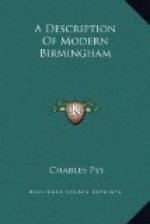Square.
There is near the centre of the town, what is called the Square; the buildings which surround it were uniform; but one eighth part was some years back fronted with stone, and converted into a tavern, which is denominated the Stork. This house of entertainment, from its private situation and being near the centre of the town, is much resorted to by travellers; there being capacious stabling behind, and in front there are some shrubs, inclosed by iron pallisadoes. For those who are at leisure, there is an excellent billiard table.
John-a-Dean’s Hole.
At the bottom of Digbeth, about forty yards from Deritend Bridge, there is on the left a water course that receives a small drain from Digbeth, and also from the adjacent lands; which stream separates the parishes of Aston and Birmingham, and is known by the name of John-a-Dean’s hole, from a person of that name who is said to have lost his life there.
Baths, near Lady Well,
Are always ready for the accommodation of hot or cold bathing, and also for immersion or amusement, together with sudorific apartments. The swimming bath is in length thirty-six yards, and in breadth eighteen yards, containing more than 2000 hogsheads of spring water, and gradually slopes from the depth of one to five feet; being situated in the centre of a garden, wherein are twenty-four apartments to undress and dress in; the whole being surrounded by a wall, ten feet high, and fine lofty trees. There are also very decent baths in Newtown-row, near Lancaster-street.
Houses.
By an accurate survey, taken in the year 1810, it appears that there were then 9196 front houses, and 8214 back houses, within the connected streets of Birmingham, which, reckoning five and a half to a house, makes the population 97,405. There appears to be about 400 houses erected annually, which will make the number at the present time 18510, and the population 101,805.
The old Roman road, denominated Ikenield-street, that extends from Southampton to Tyremouth, enters this parish near the observatory in Ladywood-lane, crosses the road to Dudley at the Sand Pits, and proceeding along Warstone-lane, leaves the parish in Hockley-brook; but is distinctly to be seen at the distance of five miles, both in Sutton park and on the Coldfield, in perfect repair, as when the Romans left it.
The Parsonage House
Of St. Martin, situated near Smallbrook-street, is in all probability one of the most ancient entire buildings in this part of the country; it being a low, half-timbered erection, surrounded by a moat; in front of which is, what was the tythe barn, being near sixty yards in length, now made use of as warehouses.




